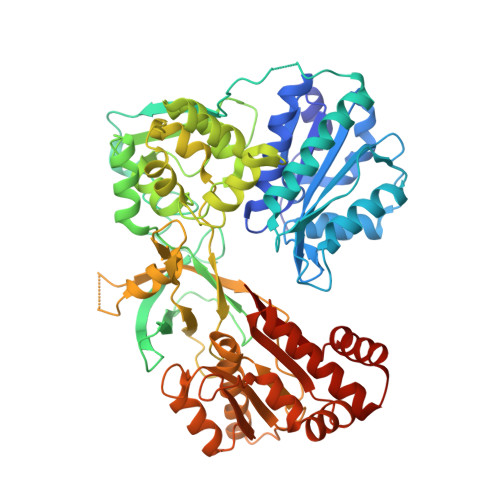Mutants of Cytochrome P450 Reductase Lacking Either Gly-141 or Gly-143 Destabilize Its FMN Semiquinone.
Rwere, F., Xia, C., Im, S., Haque, M.M., Stuehr, D.J., Waskell, L., Kim, J.J.(2016) J Biological Chem 291: 14639-14661
- PubMed: 27189945
- DOI: https://doi.org/10.1074/jbc.M116.724625
- Primary Citation of Related Structures:
4Y7C, 4Y9R, 4Y9U, 4YAF, 4YAL, 4YAO, 4YAU, 4YAW - PubMed Abstract:
NADPH-cytochrome P450 oxidoreductase transfers electrons from NADPH to cytochromes P450 via its FAD and FMN. To understand the biochemical and structural basis of electron transfer from FMN-hydroquinone to its partners, three deletion mutants in a conserved loop near the FMN were characterized. Comparison of oxidized and reduced wild type and mutant structures reveals that the basis for the air stability of the neutral blue semiquinone is protonation of the flavin N5 and strong H-bond formation with the Gly-141 carbonyl. The ¦¤Gly-143 protein had moderately decreased activity with cytochrome P450 and cytochrome c It formed a flexible loop, which transiently interacts with the flavin N5, resulting in the generation of both an unstable neutral blue semiquinone and hydroquinone. The ¦¤Gly-141 and ¦¤G141/E142N mutants were inactive with cytochrome P450 but fully active in reducing cytochrome c In the ¦¤Gly-141 mutants, the backbone amide of Glu/Asn-142 forms an H-bond to the N5 of the oxidized flavin, which leads to formation of an unstable red anionic semiquinone with a more negative potential than the hydroquinone. The semiquinone of ¦¤G141/E142N was slightly more stable than that of ¦¤Gly-141, consistent with its crystallographically demonstrated more rigid loop. Nonetheless, both ¦¤Gly-141 red semiquinones were less stable than those of the corresponding loop in cytochrome P450 BM3 and the neuronal NOS mutant (¦¤Gly-810). Our results indicate that the catalytic activity of cytochrome P450 oxidoreductase is a function of the length, sequence, and flexibility of the 140s loop and illustrate the sophisticated variety of biochemical mechanisms employed in fine-tuning its redox properties and function.
Organizational Affiliation:
From the Department of Anesthesiology, University of Michigan and Veterans Affairs Medical Center, Ann Arbor, Michigan 48105.




















